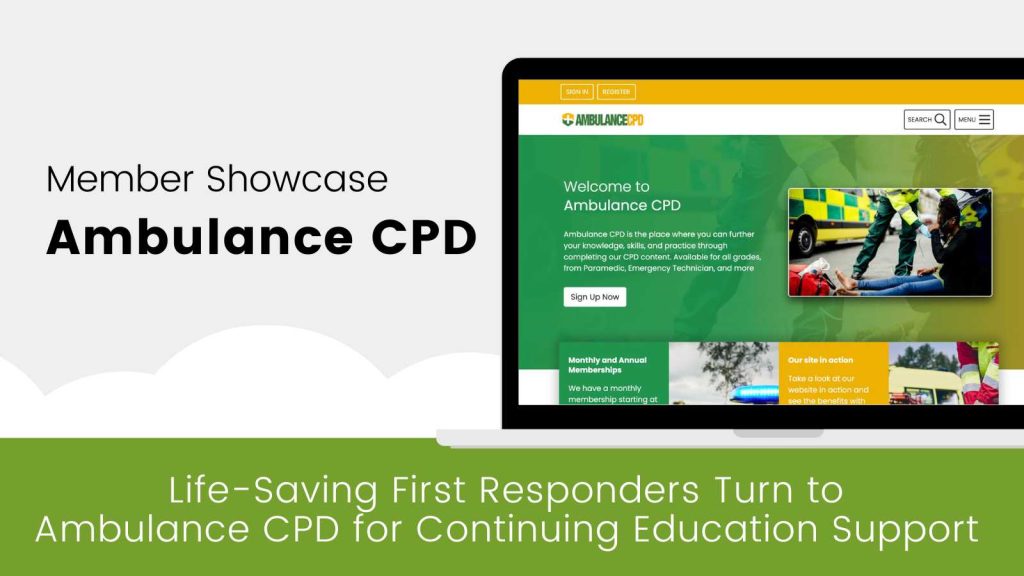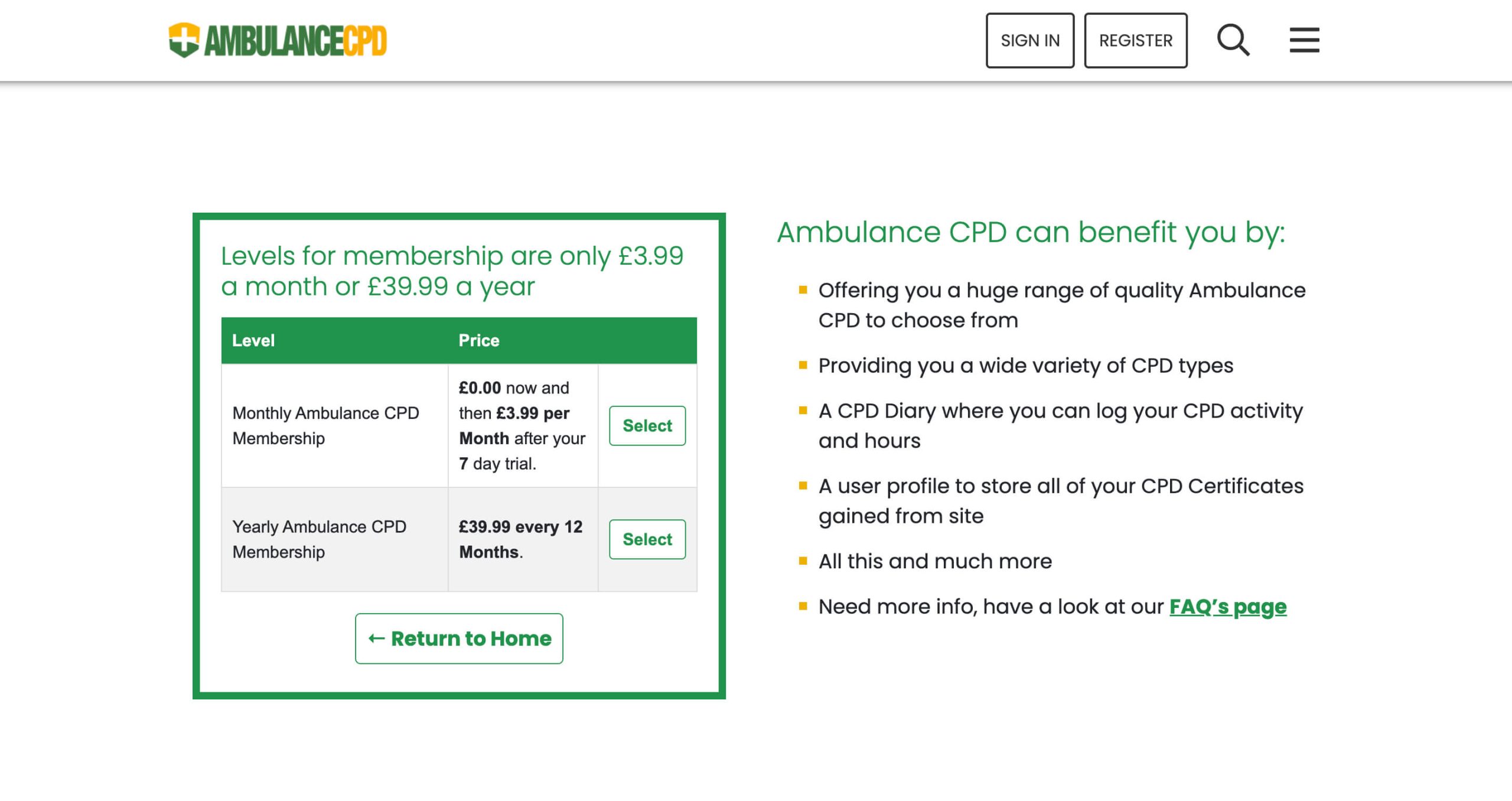There are few events in life fraught with fear and anxiety as a medical emergency. While we all hope we will not be faced with one, we can take comfort in the dedication and know-how of the professionals who come to our aid.
For first responders, this means keeping up with the most up-to-date protocols is crucial for saving lives.
Assisting in the continuing education for some of these medical services professionals— ambulance and pre-hospital staff in particular—is Ambulance CPD, founded by UK paramedic, educator, and entrepreneur Gareth Denman. Powered by WordPress and Paid Memberships Pro, Ambulance CPD is an industry-specific solution for these service providers to complete and record their Continual Professional Development (CPD), and provide the credentials when required to employers and registrars.
The website offers a rich library of professional educational content and accredited CPD courses. Courses in different medical specialties are available, including cardiovascular, pediatric, trauma, and pharmacology, as well as CBRN (chemical, biological, radiological, nuclear events) and HAZMAT (hazardous materials.)

Growing and Responding to Untapped Demand
Gareth initially created Ambulance CPD in 2015 as part of his BSc degree in advanced paramedic practice, as well as to support his colleagues. As more people started using the services he moved the content online for better accessibility and reach. Eventually, the site and its audience grew beyond its original local target, and now boasts thousands of members worldwide.
However, as Ambulance CPD’s market grew, so did its operational costs. An “edupreneur” at heart, Gareth decided to learn more about WordPress and website monetization. Research led him to settle on using a membership format that would both support the site and allow members access to an ever-expanding library of Continual Professional Development content.
For this, Gareth turned to Paid Memberships Pro, which he initially found via a Google search. With PMPro’s simple user interface, he was able to learn it fairly quickly, set up memberships, and manage access to members-only content even at its free tier. Soon, however, he upgraded to a premium level to manage memberships further and to take advantage of PMPro’s reporting tools to help monitor growth trends.

I installed the plugin, applied the correct settings and details, and it was up and running in no time.
—Gareth Denman
Gareth shares that among PMPro’s features that he finds especially helpful in supporting his e-learning membership website are:
- the ability to create different membership levels
- management of offers and promotions
- group membership
- PMPro’s simple and intuitive user interface
- reporting tools
Paid Membership Pro’s reporting tools allow Gareth to view sales, revenue, signups, and member activity. By analyzing the reports’ user trends and market impact, he can respond to fluctuations and plan for online advertising.

I am not very experienced in website building or management, but the simpleness of the plugin from the start allowed me to be able to create the website and grow it to the place it is today.
—Gareth Denman
A Multifaceted Educational Approach
Gareth never dreamed that Ambulance CPD would attract the number of members it has. His expectation of a few hundred members is now in the thousands and reaches beyond the United Kingdom.
Membership options are straightforward with Paid Membership Pro, and currently are payable monthly at £3.99 or yearly at £39.99.

Educational content is added every month, written by ambulance services providers who actively serve in the NHS [the National Health Service is the publicly funded healthcare system in the United Kingdom.] Course material targets different professional roles: paramedics, ambulance technicians, student paramedics, and responders, including community first responders, firefighter and police medical responders, first aiders, and military medics. Annual reviews ensure the course material stays current and that any necessary updates are added to keep pace with professional development requirements.
Different study formats accommodate different user learning preferences and needs, and include:
- videos
- practice quizzes
- scenario quizzes
- workbooks
- study sessions
Practice quizzes test students on a wide range of subjects, whereas scenario quizzes test knowledge and actions in a scenario setting.
Gareth shares that one of the most challenging aspects of running an online educational portal like Ambulance CPD is user support. A quick response turnaround – an occupational hazard for first responders, one could say – is a priority to support the site’s users and to assure them they are in a community of fellow paramedics.

In an industry such as healthcare, quality and reputation are vital, and it can take a very long time for people to associate your business with this. Keep being consistent and putting quality content out there to build your reputation.
—Gareth Denman
Future Growth
Looking to the next five years, Gareth is confident that Ambulance CPD’s membership base will expand further. In addition to membership growth, he plans to increase the variety and format of online content. Physical products are in the planning, as well as courses and events.
He emphasizes that building a reputation takes time, but that it is crucial to remain consistent in creating high-quality content and staying up-to-date with education, especially in a specialized field like medical services continuing education. Many of Ambulance CPD’s staff are active paramedics, which guides the company’s direction and values, and helps them connect with those they serve.
After all, the core mission of Ambulance CPD is the vital role its education plays in supporting the frontline medical professionals in whose hands we place our lives.
For more information you can follow Ambulance CPD on their social channels:
Are you ready to start growing your online course business and attracting new students?
With Paid Memberships Pro, you can create free and paid subscriptions to your course content, benefit from a wide variety of Add Ons and integrations specifically designed for selling online courses, and manage your course on WordPress.
We know that a WordPress site has tons of moving parts. Choosing the right plugins, themes, hosting, third party services, design assets, and more can feel overwhelming.
Paid Memberships Pro is a comprehensive platform built for any kind of eLearning environment. Learn exactly what you’ll get — the plugins, the support, and the training — when you build your online course with Paid Memberships Pro.
We want to showcase your membership site.
Do you run a successful membership site that uses Paid Memberships Pro? Your case study helps thousands of fellow entrepreneurs, while also giving your business loads of exposure through multiple marketing channels.
We also feature testimonials with your business name, URL, and comments throughout our website. Submit your testimonial here.

